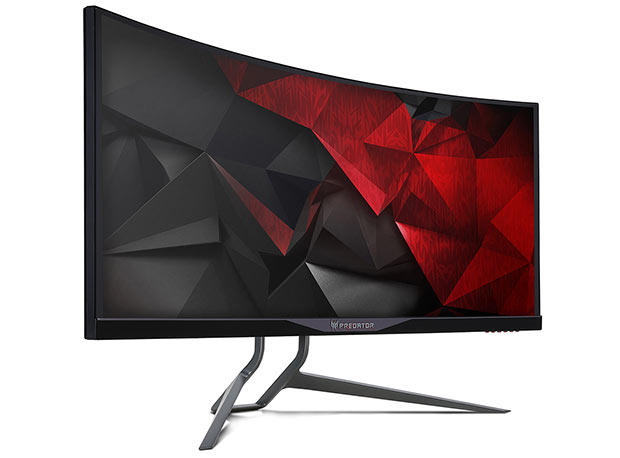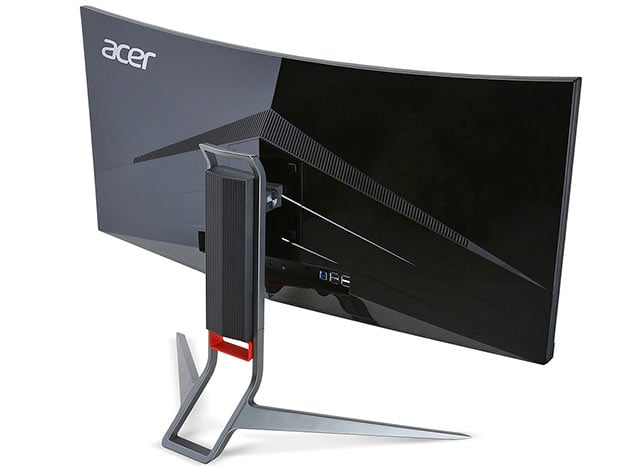The other thing that the Acer Predator X34 has going for it are killer-good looks. This monitor is thin on bezel with some other key design choices that really make it a stand-out display, though not all of those design choices are entirely practical. The panel itself has a nice, subtle 3800 millimeter curve radius. If you'd like to bone-up on the geometry behind that, Wikipedia
can help. Suffice it to say that the curve of this display is about as "just right" as we've seen. It's a big panel at 34-inches diagonal measurement, so bringing the corners in just a hair, brings them in on your peripheral vision when sitting directly in front of it.


Curved TVs haven't exactly flown off store shelves and frankly it's because they are a little silly. TV’s are meant to be view by more than one person sitting in a room and viewing angles on a curved TV can only be ideal if you’re sitting dead center, which may or may not be the case in that setting (unless you're a total anti-social hermit). Not so with a PC monitor, or at least that’s usually not the case. The single person use case is actually well-suited for a curved desktop monitor, where viewing is typically dead center of the display.

For inputs you get a single standard
DisplayPort 1.2 port and an HDMI 1.4 port, which is 60Hz capable only, a 4x1 USB 3 hub and a headphone output port. The USB hub supports 1 upstream connection from your PC and 4 downstream ports. It's not the widest array of input options here but with HDMI and a DP ports available, it'll get the job done for most users.
The Predator X34 is setup on an almost menacing looking stand which does a nice job of stabilizing this wide aspect beast. It also has a nice red accented cable pass-through guide that organizes cables directly behind the panel. Unfortunately, that's where some of these styling choices in form begin show their shortcomings in function. You’ll also notice that the back casing is black glossy plastic, which isn’t the best for the fingerprint coefficient, but since this side of the panel is usually out of sight, it’s not a big deal.
Also on the back side of the panel are a pair of stereo speakers with DTS sound. They’re powered by a 7 Watt x 2 (14W total) self-contained amp. The speaker port area is angled up and it’s a nice bonus to have in a pinch. Sound output and fidelity is actually pretty good too, with decent range and volume, though it won’t compete with a dedicated PC audio speaker system.

The tilt hinge for the stand allows a very wide range of movement up and
down and that hinge actually slides up and down inside the base as well for good flexibility in height adjustment. The handle on top makes for easy lifting of its nearly 22
pound frame. It’s a good thing that handle is there because there is absolutely no pivot capability,
which is kind of tough because the Predator X34's sharp legs could dig in on whatever surface they’re on, potentially marking it. Acer
does include some thin rubber skids on the bottom of the stand where it
makes contact with its surface area, but they have a very small contact point which still puts a lot of weight down on some fairly sharp edges. So not only do you have no pivot capability but repositioning can be a precarious affair. That said, once the panel is setup, it is very stable.


For controls, there’s a row of 6 buttons under the right edge of the panel, one is for power and the rest are for navigation. This row of little red devils can lead to such a confusing and frustrating experience trying to tweak monitor settings, that it actually takes a bit of learning curve to understand how they work together. It's certainly no deal-breaker however, and the panel does have some nice controls for lots of things like gamma, color temperature and adaptive contrast. The good news is, once you get this bad boy setup, it’s hopefully set it and forget it.

A final styling touch is the addition of a row of LED lights on the bottom edge of the display, which are configurable in the on-screen controls Ambient Lighting section. You can select a number of different hues that will then softly illuminate the surface the monitor is standing on, for a touch of "ambiance," as the setting suggests. Color accuracy purists might want to disable these lights or set them to white, in the event you need to get some high fidelity graphics work done.












